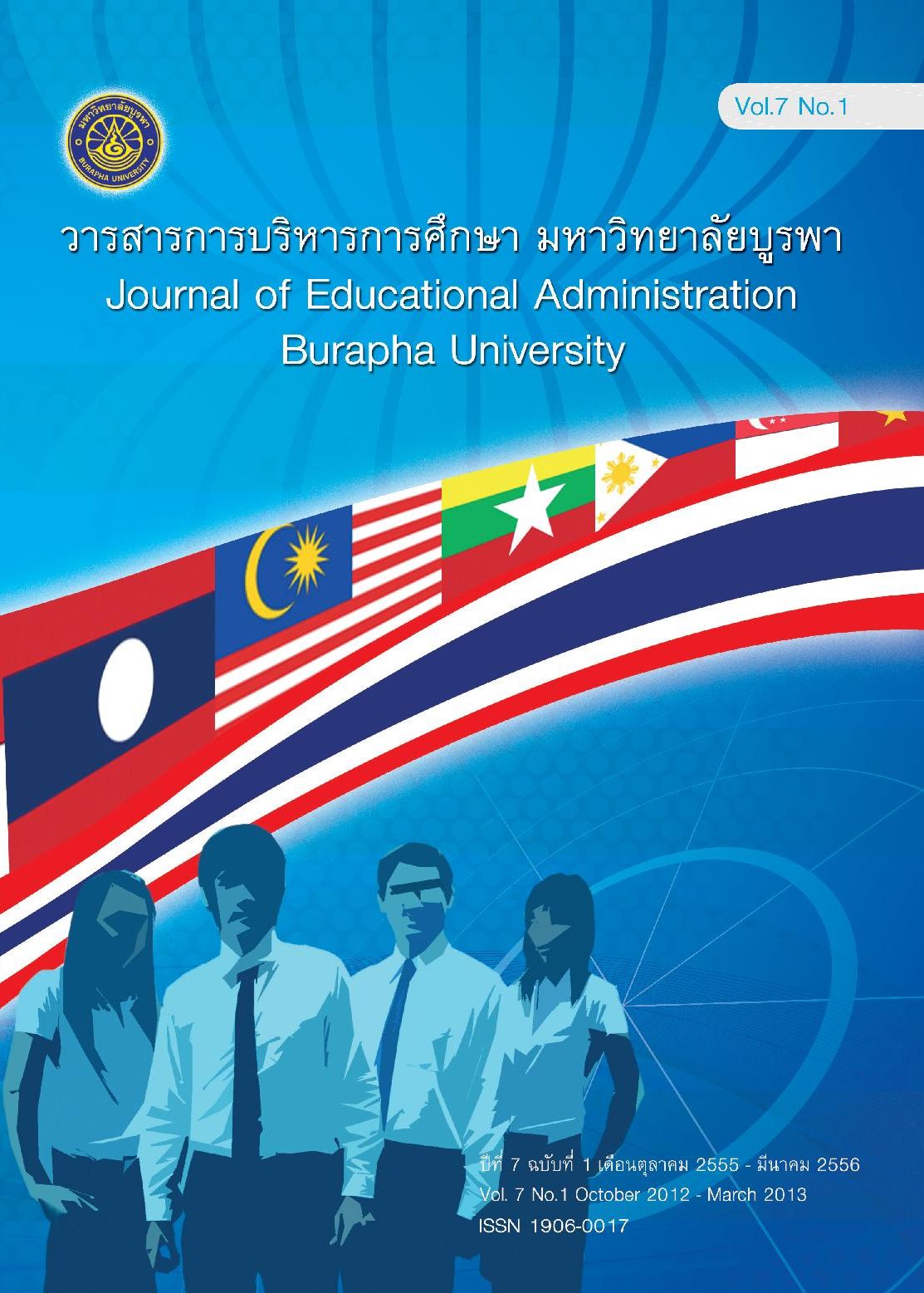โมเดลความสัมพันธ์เชิงสาเหตุของความสามารถ ในการฝ่าฟันอุปสรรคของผู้บริหารโรงเรียนสาธิต (THE CAUSAL RELATIONSHIP MODEL OF ADVERSITY QUOTIENT AMONG DEMONSTRATION SCHOOL ADMINISTRATORS)
Keywords:
โมเดลความสัมพันธ์เชิงสาเหตุ, ความสามารถในการฝ่าฟันอุปสรรคของผู้บริหารโรงเรียนสาธิต, The causal relationship model, Adversity quotient among demonstration school administrationsAbstract
บทคัดย่อ
การวิจัยครั้งนี้มีวัตถุประสงค์เพื่อพัฒนาและตรวจสอบโมเดลความสัมพันธ์เชิงสาเหตุของความสามารถในการฝ่าฟันอุปสรรคของผู้บริหารโรงเรียนสาธิตสังกัดมหาวิทยาลัยของรัฐ โดยใช้แนวคิดทฤษฎีความสามารถในการฝ่าฟันอุปสรรคของสตอลท์ซ (Stoltz, 1997) เป็นกรอบแนวคิดในการวิจัยกลุ่มตัวอย่างเป็นผู้บริหารโรงเรียนสาธิต 57 แห่งจำนวน 376 คนในปีการศึกษา 2553 ได้มาโดยการสุ่มแบบหลายขั้นตอนตัวแปรที่ศึกษาประกอบด้วยตัวแปรแฝง 6 ตัวแปรได้แก่ความสามารถในการฝ่าฟันอุปสรรค ความฉลาดทางอารมณ์ การรับรู้ความสามารถของตนเอง ภาวะผู้นำการเปลี่ยนแปลง การมองโลกในแง่ดี และการกำกับตนเอง เครื่องมือที่ใช้ในการวิจัยเป็นแบบสอบถามของตัวแปรแฝงทั้ง 6 การวิเคราะห์ข้อมูลใช้โปรแกรมคำนวณด้วยคอมพิวเตอร์ในการหาค่าสถิติพื้นฐานและใช้โปรแกรม LISREL 8.54 ในการพัฒนาและตรวจสอบความตรงเชิงโครงสร้างของโมเดลความสัมพันธ์เชิงสาเหตุ ผลการวิจัยปรากฏว่าโมเดลความสัมพันธ์เชิงสาเหตุของความสามารถในการฝ่าฟันอุปสรรคของผู้บริหารโรงเรียนสาธิต เป็นโมเดลที่มีความสอดคล้องกับข้อมูลเชิงประจักษ์ในเกณฑ์ที่ดีโดยพิจารณาจากค่า X2 เท่ากับ119.7 ที่ df เท่ากับ 106 ค่า p เท่ากับ 0.17 ค่า GFI เท่ากับ 1.00 ค่า RMSEA เท่ากับ .01 ตัวแปรทั้งหมดในโมเดลสมมติฐานอธิบายความแปรปรวนของความสามารถในการฝ่าฟันอุปสรรคได้ 64% โดยตัวแปรที่มีอิทธิพลทางตรงต่อความสามารถในการฝ่าฟันอุปสรรคอย่างมีนัยสำคัญทางสถิติได้แก่ 1) ความฉลาดทางอารมณ์ 2) การรับรู้ความสามารถของตนเอง 3) ภาวะผู้นำการเปลี่ยนแปลง 4) การมองโลกในแง่ดีและ 5) การกำกับตนเองส่วนตัวแปรที่มีอิทธิพลทางอ้อมต่อความสามารถในการฝ่าฟันอุปสรรคอย่างมีนัยสำคัญทางสถิติ ได้แก่ 1) ความฉลาดทางอารมณ์ซึ่งมีอิทธิพลทางอ้อมผ่านภาวะผู้นำการเปลี่ยนแปลงและการมองโลกในแง่ดี 2) การรับรู้ความสามารถของตนเองมีอิทธิพลทางอ้อมผ่านการกำกับตนเองและ 3) ภาวะผู้นำการเปลี่ยนแปลง ซึ่งมีอิทธิพลทางอ้อมผ่านการมองโลกในแง่ดี
ABSTRACT
The purposes of this research were to develop and to construct and validate a causal relationship model of adversity quotient among demonstration school administrators, based on the concepts of Stoltz (1997). The sample, derived by means of multi-stage random sampling, consisted of 376 educational faculties in 57 demonstration schools, in the academic year 2010. There were six latent variables namely, adversity quotient, emotional intelligent, self-efficacy, transformational leadership, optimism, and self-regulation. The research instrument was a questionnaire on the six latent variables. Data were analyzed by descriptive statistics, using a calculation computer program and using LISREL version 8.54 to develop and validate the causal relationship model. Results indicated that the causal relationship model of adversity quotient among demonstration school administrators was consistent with empirical data. Goodness of fit measures was found to be: X 2 = 119.7, df = 106, p = 0.17, GFI = 1.00, RMSEA = .01. The variables in hypothesis model explained the variation of adversity quotient 64% Variables having a statistically significant direct effect on adversity quotient were 1) emotional intelligence 2) self-efficacy 3) transformational leadership 4) optimism and 5) self-regulation Variables having a statistically significant indirect effect on adversity quotient were: 1) emotional intelligent indirectly affecting through transformational leadership and optimism 2) self-efficacy satisfaction indirectly affecting through self-regulation and 3) transformational leadership indirectly affecting through optimism.


